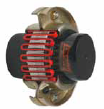The next facts is important when creating a Grid coupling selection:
Description of motor or engine, the horse electrical power (or KW), and RPM at slowest coupling velocity whilst under load
Description on the driven equipment
Shaft and keyway sizes along with the form of match for driver and driven products (clearance or interference)**
Shaft separation (BSE)
Bodily space limitations (see Application Worksheet)
Establish what the environmental problems might be, this kind of as temperature, corrosive ailments, interference from surrounding structures, and so on.
By default, sizes 1020 – 1090 might be clearance fit, sizes 1100 – 1200 will likely be interference match.
** Machines all bores and keyways to meet the dimensional and tolerance specs per ANSI/AGMA 9002-B04 for inch bores, or ISO 286-2 for metric bores.
Common grid couplings consist of two grid hubs, a grid spring, along with a cover assembly. When the shaft separation demands a spacer fashion coupling, the coupling will consist of two shaft hubs, two spacer hubs, a grid spring, in addition to a horizontal cover assembly.
Formulas Used To Determine Torque:
Application Torque (in-lbs) = ( horse electrical power x 63025 ) /RPM
Application Torque (Nm) = ( horse electrical power x 9550 ) /RPM
Selection Torque = Application Torque x Service Aspect
High Peak Loads and Brake Applications
For applications the place substantial peak loads or substantial braking torques could be present, the following added information will probably be required:
Process peak torque and frequency
Duty cycle
Brake torque rating
The selection torque formula is much like the formula shown over except that the application torque really should be doubled just before applying the  service component.
service component.
Application Torque (in-lbs) = ( horse power x 63025 ) /RPM
Application Torque (Nm) = ( horse power x 9550 ) /RPM
Selection Torque = two x Application Torque x Service Aspect
Actions In Picking A Grid Coupling
Stage one: Decide the application torque working with the formula proven over.
Phase 2: Choose the Support Issue through the charts .
For applications not displayed use the chart shown on the suitable. Decide the Assortment Torque applying the formula shown over.
Stage three: Employing the variety torque as calculated, refer on the Performance Chart
Step 4: Review the maximum bore for the dimension chosen and guarantee the necessary bore sizes never exceed the maximum allowable. If the expected bore size is greater, phase up to the following dimension coupling and check out to find out in case the bore sizes will fit.
Step five: Applying the selected coupling dimension, review the bore and keyway sizes
Stage 6: Make contact with your area industrial supplier using the portion numbers to spot sizes together with the charts for UPC element numbers.
